#Charles Burdett
Explore tagged Tumblr posts
Photo
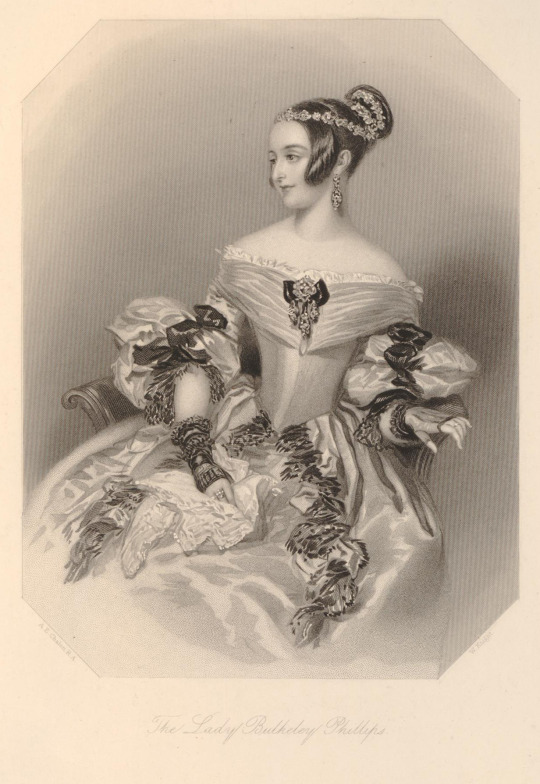
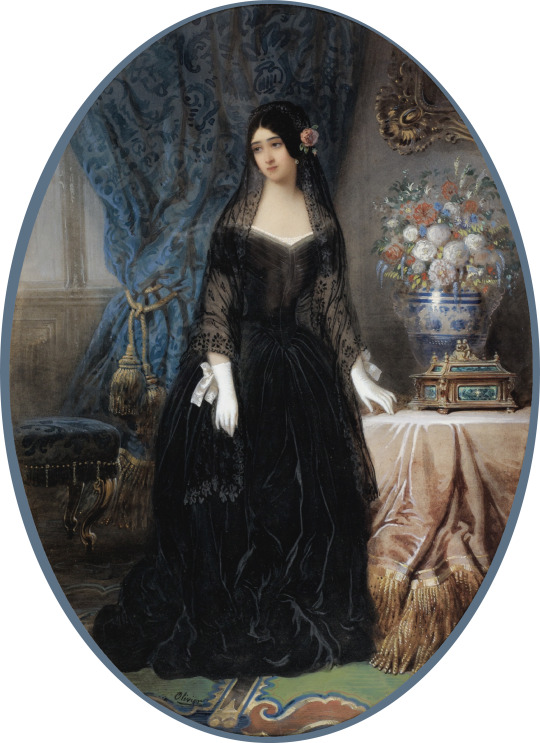


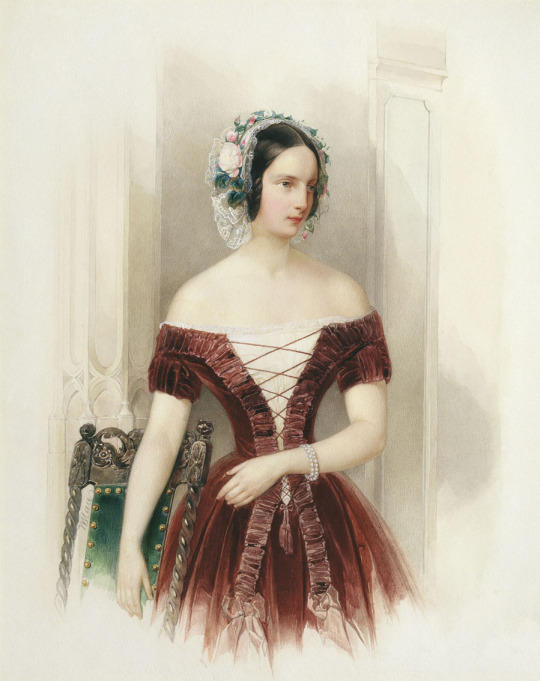

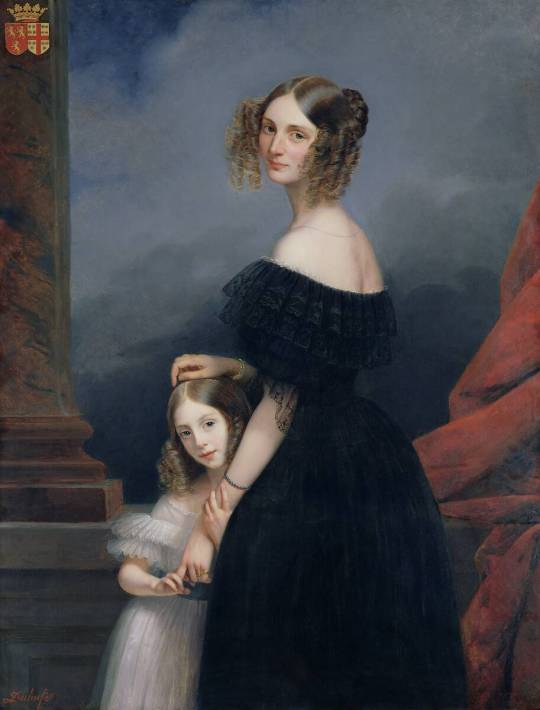

Around 1840 -
Top row 1840 Lady Eliza Gordon wearing elaborately ribboned dress by William Knight after A. E. Chalon (British Museum - London, UK). From their Web site 1232X1788.
Second row 1840s (early) Marie Duplessis as la Dame aux Camelias by Jean-Charles Olivier (auctioned by Sotheby's), From their Web site 2883X3965.
Third row ca. 1840 Angela Georgina Burdett-Coutts, Baroness Burdett-Coutts by ? (National Portrait Gallery - London UK). 2400X2969 @72 1.8Mj.
Fourth row left 1840s Zinaida Yussupova (Naryshkina) by Christina Robertson (location ?). From Wikimedia. Blured bkgnd, face and neckline removed spots 2330X2854.
Fourth row right ca. 1840 Alexandra Nikolaievna by Vladimir Hau (State Open-air Museum Peterhof - St. Petersburg, St. Petersburg Federal City, Russia). From vsdn.ru/museum/catalogue/exhibit1251.htm 899X1134..
Fifth row ca. 1840 Family of the Entrepreneur I. J. Wehle by Antonin Machek (City of Prague Museum - Praha, Czech Republic). From Animus Mirabilis' photostream on flickr 1651X2048.
Sixth row left ca. 1840 Anne-Louise Alix de Montmorency, with her daughter by Claude-Marie Dubufe (location ?) From en.muzeo.com/art-print/portrait-of-anne-louise-alix-de-montmorency/claude-marie-dubufe 913X1200.
Sixth row right ca. 1840 Former Brazilian Empress Dona Amélie of Leuchtenberg with her daughter Dona Maria Amélia, Princess of Brazil by Friedrich Dürck (Swedish Royal Collection). From Wikimedia; fixed spots & flaws w Pshop 974X1218
#1840s fashion#early Victorian fashion#Romantic era fashion#Biedermeier fashion#Louis-Philippe fashion#Eliza Gordon#William Knight#Alfred Edward Chalon#off shoulder straight neckline#pleated bertha#Marie Duplessis#Jean-Charles Olivier#veil#Angela Georgina Burdett-Coutts#straight hair#Zinaida Yussupova the elder#Christina Robertson#chemise#Alexandra Nikolaievna#Vladimir Hau#laced bodice#floral headdress#Antonin Machek#full skirt#Anne-Louise Alix de Montmorency#Claude-Marie Dubufe#side curl coiffure#Amélie of Leuchtenberg#Friedrich Dürck#off shoulder V neckline
36 notes
·
View notes
Text
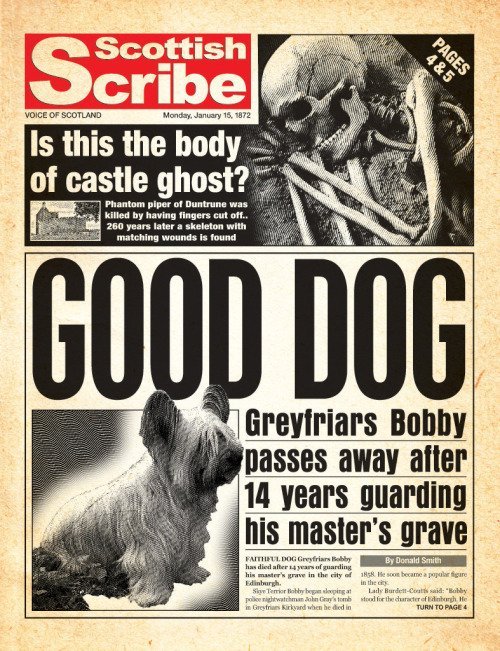

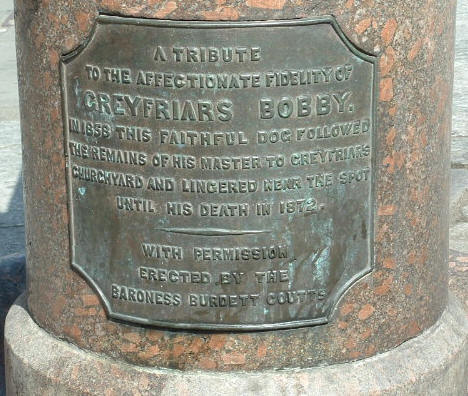

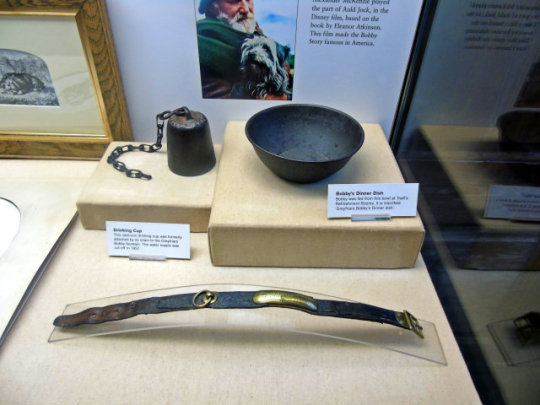
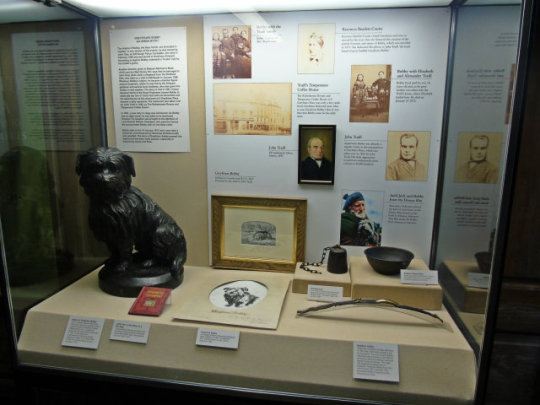
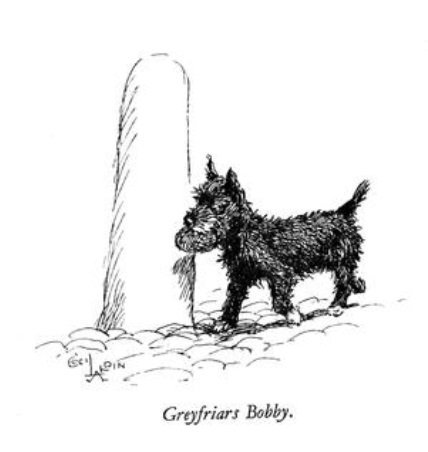
On January 14th 1872 Edinburgh’s world famous dog, Greyfriars Bobby died.
For many visitors to Edinburgh, a must-see is the statue of Greyfriar's Bobby on George IV Bridge and, although it's officially frowned upon, rubbing Bobby's nose for luck. The true story of Greyfriar's Bobby is so enchanting that even Walt Disney decided to make a movie about him.
Greyfriars Bobby was a Skye Terrier who became famous in the 19th century for his unwavering loyalty to his owner. In 1850 John Gray, his wife, Jess and their son John arrived in Edinburgh. John was a gardener but could not find employment in his new hometown, so he worked as a night watchman for the Edinburgh Police Force.
It was a lonely job, so to keep him company, he bought a wee Skye Terrier, who he called Bobby. Soon John and Bobby became inseparable through the long winter nights they maintained a watch over their charges.
Edinburgh's damp and murky weather eventually took its toll on John, who was diagnosed with tuberculosis. Despite treatment from the Police Surgeon, John died on 15th February 1858 and was buried in Greyfriar's Kirkyard.
Bobby, who had never been apart from John, refused to leave the cemetery and stayed by his owner's grave. Despite the efforts of the graveyard staff to evict Bobby, he always returned and eventually, they gave up and provided little Bobby with shelter beside John's Grave.
Word of Bobby's loyalty quickly spread, and he became a local sensation. It is said that crowds would gather outside the graveyard at one o'clock each day. When Edinburgh's famous one o'clock gun was fired, Bobby would leave the grave and join local joiner William Dow for a walk to a local coffee shop.
John and Bobby visited Traill’s Temperance Coffee House on their rounds, and Bobby was always given something to eat by the owner John Traill. This tradition continued after John's passing, thanks to the generosity of the owner.
A new by-law was passed by the Edinburgh Council in 1867, making it mandatory that all dogs had a licence and a collar. The Lord Provost of Edinburgh, Sir William Chalmers, undertook to pay for Bobby's licence, and he received a collar with the inscription "Greyfriar's Bobby from the Lord Provost 1867 Licensed".
If you visit the Museum of Edinburgh on the Royal Mile, you can see Bobby's collar and drinking bowl. as seen in the pics, that I took in 2016/.
Bobby stayed by John's grave for 14 years until he passed in 1872. He was buried in the same cemetery, just a few feet away from his beloved owner.
Greyfriars Bobby's story is one of the most enduring tales of loyalty and devotion. It serves as a reminder of the special bond between humans and animals.
In 1981 a new headstone at Bobby's Grave was unveiled by the Duke of Gloucester. The inscription reads, "Greyfriars Bobby – Died 14 January 1872 – Aged 16 years – Let his loyalty and devotion be a lesson to us all".
The legend of Bobby touched the heart of Baroness Angelia Georgina Burdett-Coutts. She was the daughter of the banker Thomas Coutts (of Coutts Bank fame) and inherited £1.8 million on her grandfather's death, making her one of the wealthiest women in England.
Burdett-Coutts spent most of her wealth on philanthropic causes. She co-founded the Urania Cottage for "fallen young women" with Charles Dickens and became a social housing pioneer.
The Baroness got permission from Edinburgh Council to erect a statue of Bobby at the junction of Candlemakers Row and George IV Bridge, just outside Greyfriars Kirkyard. The artist William Brodie was commissioned to create the statue in 1872.
Since its unveiling, the statue of Bobby has become an important Edinburgh landmark.
155 notes
·
View notes
Text
CHARACTER LIST
Fine, I'm fine - Fifi He/him, 23, pansexual "talks like this" tagline is: "Everything's fine! [Fifi]" - 20XX - Mana He/him, 23, pansexual "talks like this" tagline is: "Slut for keychange! [Mana]" - NRFTW - Chon Wick He/him, 22, pansexual "talks like this"
tagline is: "YEEHAW MOTHERFXCKS! [Chon Wick]" - Count Eleven - Elve He/They, 24, unlabeled "talks like this"
tagline is: "One two eleven count! [Elve]" - TTDL - Linear He/they/it, 24, unlabeled "talks like this"
tagline is: "breath in and out [Linear]" - Aw/mT - Astronaut He/him, 22, pansexual "talks like this"
tagline is; "the universe keeps on going [Astronaut]" - TFFTT triplets - Birch, Woods, Asher Birch - he/him, 24, bisexual Woods - he/they, 24, unlabeled Asher - he/it, 24, panromantic Birch "talks like this" Woods "talks like this" Asher "talks like this"
taglines are: "TRIPLETS BORN, THE FOREST WAITS! [TFFTT triplets]" /ref "the trees have eyes [Birch]" "handprints are red for a reason buddy [Woods]" "let me burn them down [Asher]" - YSLLB - Louis He/They, 24, pansexual
"talks like this"
tagline is: "Yes I look like Louis Burdette I am him! [Louis]" - The before - Atticus He/It, 22, unlabeled
"talks like this"
tagline is: "So many emotions so little time to process [Atticus]" - Covered in discontent - Moss He/Him, 22 - 23, pansexual
"talks like this"
tagline is: "Legends I will tell and travel to [Moss]" - Mario is dead - Mari He/it, 22, unlabeled?
"talks like this"
tagline is: "MARIO IS DEAD!! [Mari]" - Heal - Medic He/they, 24, unlabeled
"talks like this"
tagline is: "the evil power draws nearby [Medic]" - THD.PH - Devil He/They, 23, pansexual
"talks like this"
tagline is: "Shut up you're stupid [Devil]" - WW.PH triplets - Jouse/Jerry, Tomcat (Tom), Willard Jerry - he/it, 23, unlabeled Tomcat - he/it, 23, unlabeled Willard - he/him, 23, panromantic
Jerry "talks like this" Tomcat "talks like this" Willard "talks like this"
taglines are: "Were the MAIN CHARACTERS so you have to like us! [WWPH triplets]" "cheese is tasty! [Jerry]" "Milk is being craved right now... [Tomcat]" "... [Willard]" - Ego - Cage He/they, 23, pansexual
"talks like this"
tagline is: "imperfection grew on me [Cage]" - CJ.PH - Mae He/him, 23 - 24, pansexual
"talks like this"
tagline is: "lies in black and white [Mae]" - K.K cruisin' - Slider He/him, 23, unlabeled
"talks like this"
tagline is: "want some bubblegum? [Slider]" - GW,ORTLH - Announcer/Narrator/Mathias He/they/it, ??? (the oldest), no labeled (supposedly pansexual)
"talks like this"
tagline is: "let me tell you a story~ [Announcer/Narrator/Mathias] - CCCC quad - Mr. Helio, Mr. Lune, Mr. Patho, Mr. Harmonia Mr. Helio - he/it, 22, pansexual Mr. Lune - he/they, 22, pansexual Mr. Patho - he/they/it, 22, pansexual Mr. Harmonia - he/him, 23, pansexual
Helio "[talks like this]" Lune "(talks like this)" Patho "{talks like this}" Harmonia "talks like this"
taglines are: "We think we're playing in a band! [CCCC quad]" "My logic is the absolute. [Mr. Helio]" "Think of these thoughts as hackened. [Mr. Lune]" "Call me your host or call me insane! [Mr. Patho]" "The whole world and you! [Mr. Harmonia]" - Drum covers - Charles He/him, 21 (the youngest), pansexual
"talks like this"
tagline is: "Charlotte I wanna know you more! [Charles]" - The Ship of Theseus - Theseus He/him, 21 - 22, unlabeled
"talks like this"
tagline is: "build and build until it's different [Theseus]" - Original Character - Muse She/They/it, 23, uranic
"talks like this"
tagline is: "winter valentine love you all the time [Muse]" - BONUS CHARACTER - Clunk it/it's, no age, unlabeled
funky robot fella!
tagline is: "I am Clunk"
-
BONUS CHARACTER 2 - Darrell/Daralle it/it's, no age, chicken
it's the hen!!
tagline is: "bawk bawk!" -
more will be added once there's more!
#cj hms#cccc#cccc rp#sort of#chonnyverse#STUDIO SNEEBS RP#cccc heart#cccc mind#cccc soul#cccc whole#chonny jash power hours#chonny tmph#chonny thdph#chonny wwph#chonny cjph#sorry for such a long list but I had to HAHAH!! /ooc
20 notes
·
View notes
Text



















From the Golden Age of Television
The First Flight of the Wright Brothers - CBS - January 16, 1955
A presentation of "You Are There" Season 3 Episode 21
Historical Reenactment
Running Time: 30 minutes
Directed by Jack Gage
Narrated by Walter Cronkite
News Reporters:
Harry Marble
Ned Calmer
Lou Cioffi
Winston Burdett
Bill Leonard
Stars:
James Gregory as Wilbur Wright
William Prince as Orville Wright
Rusty Lane as Professor Samuel Langley
Vaughn Taylor as Bishop Milton Wright
Augusta Dabney as Katherine Wright
P. Jay Sidney as Paul Dunbar
Charles Dingle as Simon Newcombe
#The First Flight of the Wright Brothers#TV#You Are There#CBS#1955#1950's#Historical Reenactment#Walter Cronkite#James Gregory#William Prince#Rusty Lane#Vaughn Taylor#August Dabney
3 notes
·
View notes
Text

"A Piece of the Action" (1977) is a comedy film directed by Sidney Poitier and stars Poitier and Bill Cosby. It is the third installment of the unofficial Uptown Trilogy, including "Uptown Saturday Night" (1974) and "Let's Do It Again" (1975). Charles Blackwell and Timothy March wrote the film, featuring Denise Nicholas, Hope Clarke, James Earl Jones, Tracy Reed, and Titos Vandis. Additional cast members are several young actors and actresses who are part of the community youth center in the film. Many were familiar faces in T.V. during the 70s, including Ernest Thomas, Bryan O'Dell, Eric Laneuville, Tamu Blackwell, and Sheryl Lee Ralph. Curtis Mayfield produced the soundtrack, and Mavis Staples was the vocals on the album.
Sidney Poitier applied some elements from "To Sir, with Love" in "A Piece of the Action." While the film isn't school-themed, the teenagers are of high school age, and there were significant teachable moments from Poitier. He used the 'common courtesy' exercise in "To Sir, with Love," "A Piece of the Action," and "To Sir, with Love II." Youth community centers are meaningful aspects for inner-city children. They allow children to learn outside of the school environments, and "A Piece of the Action" shows the importance of teaching students about the real world.
Overall, "A Piece of the Action" is a fun movie. The cast is legendary, and the messages still hold today.
Director: Sidney Poitier Writers: Charles Blackwell, Timothy March
Starring Sidney Poitier, Bill Cosby, James Earl Jones, Denise Nicholas, Hope Clarke, Tracy Reed, Ja'net DuBois, Frances Foster, Ernest Thomas, Eric Laneuville, Sheryl Lee Ralph, Titos Vandis, Jason Evers, Marc Lawrence, Edward Love, Bryan O'Dell, Dianne Oyama Dixon, Larry Beecham, Karole Selmon, Tamu Blackwell, Gammy Burdett, Wonderful Smith
Storyline Dave Anderson (Bill Cosby) and Manny Durrell (Sidney Portier) are two high-class sneak thieves who have never been caught. Joshua Burke (James Earl Jones) is a retired detective with enough evidence to put them behind bars. Instead, he offers to maintain his silence if the crooks will go straight and do work at a youth center for delinquents. At first, the thieves are reluctant (and so are the kids). As time passes, they gain the kids' trust and admiration and enjoy the job. All goes well until someone out of the past tells them they must do one last heist.
Available on DVD and streaming services
14 notes
·
View notes
Text
Le refuge des femmes perdues, Stacey Halls
Rentrée littéraire 2024

Dans le Londres de 1847, l’écrivain Charles Dickens et la baronne philanthropique Angela Burdett-Coutts viennent de créer un refuge, une institution pour les femmes qui souhaitent se réinsérer dans la société après une peine de prison ou une vie de débauche. Les anciennes voleuses, prostituées ou femmes déchues ont désormais un lieu où peut démarrer leur seconde chance… mais le veulent-elles toutes vraiment ?
Cette fois, il n’y a pas deux personnages féminins que tout oppose et qui vont malgré tout se rapprocher ; mais trois ! J’ai retrouvé avec joie le style de Stacey Halls, et j’ai dévoré son nouveau roman en trois jours à peine. J’ai beaucoup aimé les personnages. Angela, qui essaye de s’en sortir alors qu’elle se fait harceler par un homme étrange depuis des années ; Martha, qui tente de retrouver la trace de sa petite sœur et de démarrer une nouvelle vie ; Josephine, qui sort à peine de prison et pensait commencer sa seconde chance avec Anna, pour qui elle a de forts sentiments et pour qui elle risque de tout envoyer valser… J’ai adoré ces portraits hauts en couleur et remplis d’émotion.
Surtout, j’ai beaucoup aimé découvrir ce lieu qui a réellement existé ! J’ai trouvé la mission de Dickens sincèrement belle, surtout pour l’époque victorienne rigide et remplie de jugements. Ces parcours de vie m’ont bien plu, et j’ai vraiment apprécié que Stacey Halls ajoute un aspect flippant/révoltant avec Angela et son harceleur… jusqu’à un moment où ça fait bien froid dans le dos.
C’est pas mon préféré (pour l’instant aucun ne détrône Les Sorcières de Pendle ni La Nurse du Yorkshire), mais j’étais ravie de lire un nouveau roman de Halls ! (Et vivement le prochain ! 🤭)
30/08/2024 - 01/09/2024
1 note
·
View note
Text

"Achieve Goals in Victory Loan Drive," Windsor Star. October 27, 1943. Page 5. --- PENBERTHY Injector Company, another of the scores of smaller Windsor firms which have done a consistently good job in Victory Loan drives, has again accomplished their task in the present drive by going well over the top. Shown in the upper photograph are some of those who conducted the drive in the plant and others who bought substantially. Left to right are: Mr. William Decker, who invested his savings of $3.000; Mr. Bob Sampson, salesman; Mr. Charles Hugill, salesman, and Mr. David Jennison, another bond buyer, who has a son in the R.C.A.F. The firm is now trying for a 3- Star Victory Flag. Below, at the plant of the Windsor Tool and Die Company, employes raised the classification of their firm from "C" to "A" in the Fifth Victory Loan effort. Some of those responsible are shown, left to right: Mr. William Brenie, Mr. Fred Burrell, Mr. William Burdett, Mr. Armand Guidolin, employes who invested substantial amounts of their savings from $500 to $800, and Mr. E. B. Lane, president and general manager of the company. Fullest co-operation was shown between employes and management in the conduct of the drive. All of the employes shown have relatives in the services. An honor certificate was presented to the employes yesterday. (By Staff Photographer.)
#windsor#machine workers#machine tools#tool and dye company#victory bonds#victory bond campaign#war workers#industrial workers#working class culture#canada during world war 2
0 notes
Text
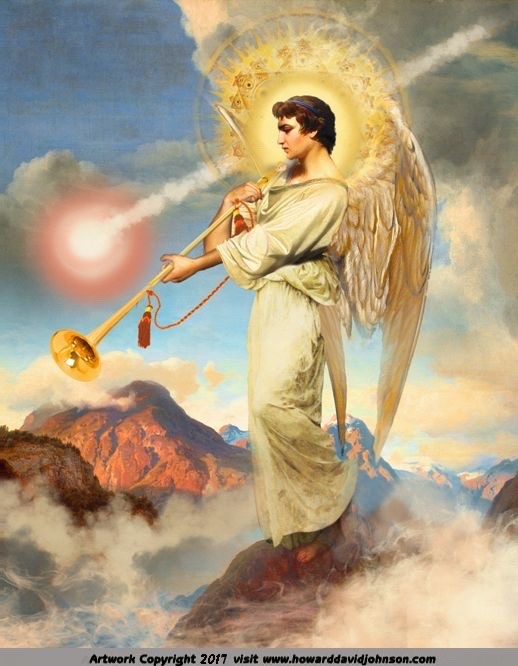
‘spelling with Brandon’s family’
BECOME A HERO WITH ME
LISTEN CLOSELY
PLEASE COME HERE TO SAVE MY LIFE
Send LOYAL gentlemen
Pro Female
Pro Gay
Pro hermaphrodite
Pro heterosexual
Pro Russia Beauty
“DORI”
“NAZI NEMO”
“VOGUE MAGAZINE”
“ONION BUNNY SKIN FACTORY”
“ONION RABBIT SKIN FACTORY”
LIST OF NAMES
HOWEVER ONLY REQUIRE SAFE HOUSE ME
Brandon Burdett
Sarah Kaye Burdett Rivera Leeper
Jessica Rivera
Jacob Rivera
Justin Rivera
Kevin Rivera
Patrick Rivera
Cara Burns
Clete Burns
Pamela Burns
Martha Burns
“tacom wa”
“tacoma wa” WHITE TRASH LABS
THOUSANDS OF WHITE COVER UPS
“mckinney tx”
“princeton tx”
“dallas tx”
“asutin tx”
“charles port”
“lakewood wa”
“tacoma wa”
CLAIRVOYANT
PLEASE SEND LOYALISTS FOR A RUSSIAN SAFE HOUSE
OR THEY PLAN TO “LAB” and ASSASSINATE ME
PLEASE SEND LOYAL “ESCARGOT” coverups
USA TRIES TO BLAME RUSSIA
DUNGEONS “ONION BALLS”
Brandon Wayne Burdett
Bee’s Moon’s Bird’s
Require a russian safe house
206-209-9841
grand pacific apartments
7015 S D St
Tacoma, WA 98408
United States
NEXT TO FRED MYERS
NEXT TO ZIPS CANNIBAS
WORLD WAR SKIN FACTORY
WORLD WAR ASTROLOGY
WORLD WAR CASTRATIONS
ZERO “tacoma wa”
MASS MURDERS ARE PRESENT
MASS ASSASSINATIONS ARE PRESENT
SAVE OUR BABIES FROM CASTRATION
No england
No germany
“tacoma wa” white power castration “SHOE OLVIES”
mckinney tx” “MAC CAMERA KID HAM BURGERS”
NOODLE HE MON GLOBAL BEN
NOODLE HE
NOODLE SAINT BENARD
this is how MASS MURDER
this is how USA SOIL ASSASSINATES BABIES
this is how WHITE RATS tries spells Brandon
this is how BLACK RATS tries spells Brandon
SAVE YOUR BABIES
SAVE OUR BABIES
WENDY’S SOVIET UNION
SSR JEWISH RUSSIA
SAVE OUR LOYAL GENTLEMEN
SAVE OUR RIGHTEOUS HONORS
SEND FOR A RUSSIAN SAFE HOUSE
Russian Seers
SS
Alwayssssssss
Blessingsssssss
SSR JEWISH SEERS
SSR RUSSIA BABIES
I will only roSSe my Olivér Gardénia
this day onwards is my Jewish Rose
Rose Jewish Seers
Thats how i maintain my focus,
so people cant ventriloquist
THIS IS HOW TO FOCUS
THIS IS HOW TO CAST LOCUSTS
If you want to dominate
Heaven; Gothic Irish Harps
Science Labs; Amish Lizzy
Blood; Swiss Banks
Soul; Male Roses
Battles; Cats and Snakes
Cats, gargoyles, and snakes
Swiss Banks
Gothic Castles
Amish Lizard Hydra's
Rose Jewish Seers
always séance easygoing seers
SSR JEWISH RUSSIA
ss hercules vladimire
https://linktr.ee/brandonwayneb (https://linktr.ee/brandonwayneb)
0 notes
Note
What happened to that kid Burr brought back from Europe? Did Burr raise him? Nobody ever talks about him...
homie, are you gasliting me?/j spent an hour checking the books I have at hand at the moment, questioning my sanity and I'm pretty sure Burr brought no kid from Europe. It would have been rather difficult for him in general, considering he barely had any money by the time he boarded Aurora, and when I say "barely" I'm being oh so generous. there are two vague mentions of some "boy" in his journals, specifically:
"Left on board two or three light articles, which the boy and I had brought in our hands" "At leaving Boston I gave Tom my silver pencil, which I have wanted a dozen times since."
And that's about it. He doesn't mention anyone being in his company the entire time, speaks about having a room all to himself etc.
If we consider the possibility it could have been some kid of his, none of them fit the time period. The closest one to it are Charles Burdett, who according to Burr's public papers was born either in 1813 or 1814, and Aaron Columbus Burr who wasn't conceived in Europe if my memory serves me right but was sent to Burr in 1813 according to Lomask. If you meant any of them do let me know.
1 note
·
View note
Note
Can you give a summary of all of Burrs kids? idk he had any besides Theo
Oh, he had so many kids. He, like.... collected at-risk children & teenagers.
1. “Chestnutiana”
There is this very strange story associated with Burr (that I can’t find any additional information on, so it is most likely NOT true—I just find it interesting so I figured I’d mention it), where when Burr allegedly had a child with a woman named Jacataqua. She was the daughter of an Abenaki chief serving as a guide during the Battle of Quebec period of the Revolution.
There’s very little information about it so to me it kind of just sounds like an attempt to make up a story similar to the Lewis & Clarke Expedition—because their guide was also a Native who had a child during the journey as well. The circumstances are weird because neither the mother OR the child died, but they were split up anyway? Burr & Jacataqua just decided to send her to be raised by this random Scottish soldier that he met on the battle field that offered it?
Meanwhile she was given a random cabin somewhere in New York. None of the details really make sense & there aren’t any records, but I guess it’s always a possibility given how secretive Burr was. Plus, there is no documented proof connecting him to Mary Emmon’s two children & we have DNA confirmation that he IS their father, so… eh, worth noting.
2. Theodosia Burr
Born in 1783; 1st child with Theodosia Sr. After his wife died, she was arguably Burr’s best friend. As an adult he confided everything to her. Died in 1813 as the result of a ship wreck. The event permanently changed Burr’s demeanor.
3. Augustine James Frederick Prevost
Born 1766; Burr’s stepson from Theo Sr.’s 1st marriage; nicknamed Frederick. Burr tried his hardest to raise him like his own child, but he and Frederick had a bit of a strained relationship (more info about him [HERE.])
4. John Bartow Prevost
Born either 1767 or 1768; Burr’s stepston from Theo Sr.’s 1st marriage; nicknamed Bartow. He and Burr appeared to have a much closer relationship, with Burr using his Vice President status to grant him a position (more info about him [HERE.])
5. Sally Burr
Born in 1785; 2nd child with Theodosia Sr. She died a couple of years later, barely 3 years old. Not quite sure how, but it seemed to be a sort of intestinal/digestive-related problem, so she most likely died of malnutrition or dehydration because of not being able to absorb her food properly.
6. Unnamed Boy
Born [N/A]; 3rd child with Theodosia Sr. Stillborn.
7. Lousia Charlotte
Born 1788; 1st child with Mary Emmons. Mary was an Indian slave (who may have belonged to Theodosia Sr.) who Burr had a longstanding affair with. Why, how, or what the circumstances were remain a mystery.
8. Unnamed Boy
Born [N/A]; 4th child with Theodosia Sr. Stillborn.
9. John Pierre
Born 1792; 2nd child with Mary Emmons.
10. Nathalie de Lage
Born 1782; daughter of French aristocrats that Burr took care of from age 11 to 18 when she immigrated to America during the French Revolution. Theo Jr. & her were extremely close.
11. Susan Reynolds
Born [N/A]; Not Burr’s child (though, apparently there was a rumor at the time that she was); Burr was Maria Reynolds’ divorce lawyer in 1793, and he went out of his way to petition for Susan to get a higher education, spending a lot of his own money as well.
12. John Vanderlyn
A painter who Burr may or may not have met on accident? Burr financed his education.
13. Aaron Columbus Burr
Born 1808; apparently born Aaron Burr Colombe. Worked as a silver/goldsmith & tried to start a freed black colony in Honduras, which is cool. He is referred to in his obituary as “Aaron Burr’s adopted son.”
14. Charles Burdett
Born 1814; died as a young adult (48), but before that he worked as a Postmaster Assistant, an assistant to at least two New York mayors (Westervelt & Kingsland), and wrote at least 10 books. He is referred to in his obituary as “Aaron Burr’s adopted son.”
15. Henry Oscar Taylor
Born 1818; very little information exists, but he is documented to have lived with Burr by at least 1833. Strangely, he was also a Witness when Burr rewrote his will.
16. Sydney Burr (?)
Born [N/A];Adding a question mark to the name because this name randomly appeared on Burr’s Wikipedia one day (and is now no longer there) & no source I’ve ever read has ever mentioned them. Might as well put it here for future reference.
17. Frances Ann Burr
Born 1827; Most likely not Burr’s biological daughter (as funny as that would be) because Burr was 73. Not unheard of to be virile at that age, just unlikely. Either way, Burr wrote her into his will & claimed her as his daughter.
18. Elizabeth Burr
Born 1833; definitely not his biological daughter, because he was 77 & partially paralyzed waist-down. Either way, she was also written into his will as his daughter.
#Aaron Burr#Theodosia Burr#Theodosia Burr Alston#Charles Burdett#Aaron Columbus Burr#Mary Emmons#Louisa Charlotte Burr#John Pierre Burr#Burr Family
88 notes
·
View notes
Text
Joseph Merrick - Part 3
Joseph Carey Merrick (5 August 1862 – 11 April 1890), often erroneously called John Merrick, was an English man with severe deformities. He was first exhibited at a freak show as the "Elephant Man", and then went to live at the London Hospital after he met Frederick Treves, subsequently becoming well known in London society.
[Part 1] • [Part 2]
~ LONDON HOSPITAL ~
With Joseph Merrick admitted into the hospital on June 1886, Frederick Treves now had time to conduct a more thorough examination. He discovered that Merrick's physical condition had deteriorated over the previous two years and that he had become quite crippled by his deformities. Treves also suspected that Merrick now suffered from a heart condition and had only a few years left to live. Merrick's general health improved over the next five months under the care of the hospital staff. Although some nurses were initially upset by his appearance, they overcame this and cared for him.
The problem of his unpleasant odour was mitigated through frequent bathing and Treves gradually developed an understanding of Merrick's speech. A new set of photographs was taken. The question of Merrick's long-term care had to be addressed. Francis Carr Gomm, the chairman of the hospital committee, had supported Treves in his decision to admit Merrick, but by November, long-term plans needed to be made. The London Hospital was not equipped or staffed to provide care for the incurable, which Merrick clearly was.
Carr Gomm contacted other institutions and hospitals more suited to caring for chronic cases, but none would accept Merrick. Gomm wrote a letter to The Times, printed on 4 December, outlining Merrick's case and asking readers for suggestions. The public response—in letters and donations—was significant, and the situation was even covered by the British Medical Journal. With the financial backing of the many donors, Gomm was able to make a convincing case to the committee for keeping Merrick in the hospital. It was decided that he would be allowed to stay there for the remainder of his life. He was moved from the attic to two rooms in the basement adjacent to a small courtyard. The rooms were adapted and furnished to suit Merrick, with a specially constructed bed and—at Treves's instruction—no mirrors.
Merrick settled into his new life at the London Hospital. Treves visited him daily and spent a couple of hours with him every Sunday. Now that Merrick had found someone who understood his speech, he was delighted to carry on long conversations with the doctor. Treves and Merrick built a friendly relationship, although Merrick never completely confided in him. He told Treves that he was an only child, and Treves had the impression that his mother, whose picture Merrick always carried with him, had abandoned him as a baby. Merrick was also reluctant to talk about his exhibition days, although he expressed gratitude towards his former managers. It did not take Treves long to realise that, contrary to his initial impressions, Merrick was not intellectually impaired.

[The only surviving letter written by Merrick. Wikipedia]
Treves observed that Merrick was very sensitive and showed his emotions easily. At times Merrick was bored and lonely, and demonstrated signs of depression. He had spent his entire adult life segregated from women, first in the workhouse and then as an exhibit. The women he met were either disgusted or frightened by his appearance. His opinions about women were derived from his memories of his mother and what he read in books. Treves decided that Merrick would like to be introduced to a woman and it would help him feel normal. The doctor arranged for a friend of his named Mrs. Leila Maturin, "a young and pretty widow", to visit Merrick. She agreed and with fair warning about his appearance, she went to his rooms for an introduction. The meeting was short, as Merrick quickly became overcome with emotion. He later told Treves that Maturin had been the first woman ever to smile at him, and the first to shake his hand. She kept in contact with him and a letter written by Merrick to her, thanking her for the gift of a book and a brace of grouse, is the only surviving letter written by Merrick. This first experience of meeting a woman, though brief, instilled in Merrick a new sense of self-confidence. He met other women during his life at the hospital, and appeared taken with them all. Treves believed that Merrick's hope was to go to live at an institution for the blind, where he might meet a woman who could not see his deformities.
Merrick wanted to know about the "real world", and questioned Treves on a number of topics. One day he expressed a desire to see inside what he considered a "real" house and Treves obliged, taking him to visit his Wimpole Street townhouse and meet his wife. At the hospital Merrick filled his days with reading and constructing models of buildings out of card. He entertained visits from Treves and his house surgeons. He rose each day in the afternoon and would leave his rooms to walk in the small adjacent courtyard, after dark.

[Card church built by Merrick, a replica of Mainz cathedral. Wikipedia]
As a result of Carr Gomm's letters to The Times, Merrick's case attracted the notice of London's high society. One person who took a keen interest was actress Madge Kendal. Although she probably never met him in person, she was responsible for raising funds and public sympathy for Merrick. She sent him photographs of herself and employed a basket weaver to go to his rooms and teach him the craft. Other ladies and gentlemen of high society did visit him however, bringing gifts of photographs and books. He reciprocated with letters and hand made gifts of card models and baskets. Merrick enjoyed these visits and became confident enough to converse with people who passed his windows. A young man, Charles Taylor, the son of the engineer responsible for modifying Merrick's rooms, spent time with him, sometimes playing the violin. Occasionally, he grew bold enough to leave his small living quarters and would explore the hospital. When he was discovered, he was always hurried back to his quarters by the nurses, who feared he might frighten the patients.
On 21 May 1887, two new buildings were completed at the hospital and the Prince and Princess of Wales came to open them officially. Princess Alexandra wished to meet the Elephant Man, so after a tour of the hospital, the royal party went to his rooms for an introduction. The princess shook Merrick's hand and sat with him, an experience that left him overjoyed. She gave him a signed photograph of herself, which became a prized possession, and she sent him a Christmas card each year.
On at least one occasion, Merrick was able to fulfil a long-held desire to visit the theatre. Treves, with the help of Madge Kendal, arranged for him to attend the Christmas pantomime at the Theatre Royal, Drury Lane. Treves sat with some nurses, concealed in Lady Burdett-Coutts' private box. According to Treves, Merrick was "awed" and "enthralled". "The spectacle left him speechless, so that if he were spoken to he took no heed." For weeks following the show Merrick talked about the pantomime, reliving the story as if it had been real.
~ LAST YEARS ~
On three occasions Merrick left the hospital and London on holiday, spending a few weeks at a time in the countryside. Through elaborate arrangements that allowed Merrick to board a train unseen and have an entire carriage to himself, he travelled to Northamptonshire to stay at Fawsley Hall, the estate of Lady Louisa Mary Knightley. He stayed at the gamekeeper's cottage and spent the days walking in the estate's woods, collecting wild flowers. He befriended a young farm labourer who later recalled Merrick as an interesting and well-educated man. Treves called this "the one supreme holiday of [Merrick's] life", although in fact there were three such trips.
Merrick's condition gradually deteriorated during his four years at the London Hospital. He required a great deal of care from the nursing staff and spent much of his time in bed, or sitting in his quarters, with diminishing energy. His facial deformities continued to grow and his head became even more enlarged. He died on 11 April 1890, at the age of 27. At around 3:00 p.m. Treves's house surgeon visited Merrick and found him lying dead across his bed. His body was formally identified by his uncle, Charles Merrick. An inquest was held on 15 April by Wynne Edwin Baxter, who had come to notoriety conducting inquests for the Whitechapel murders of 1888.
Merrick's death was ruled accidental and the certified cause of death was asphyxia, caused by the weight of his head as he lay down. Treves, who performed an autopsy, said Merrick had died of a dislocated neck. Knowing that Merrick had always slept sitting upright out of necessity, Treves said "He often said to me that he wished he could lie down to sleep 'like other people' ... he must, with some determination, have made the experiment ... Thus it came about that his death was due to the desire that had dominated his life—the pathetic but hopeless desire to be 'like other people'."
Treves dissected Merrick's body and took plaster casts of his head and limbs. He took skin samples, which were later lost during the Second World War, and mounted his skeleton.
There is a small museum dedicated to his life, housing some of his personal effects, and a new replica of his skeleton went on display in 2012. His remains in a glass case in a private room at the university can be viewed by medical students and professionals by appointment, to "allow medical students to view and understand the physical deformities resulting from Joseph Merrick's condition". Although the Queen Mary University of London intends to keep his skeleton at its medical school, some are contending that as a devout Christian Merrick should be given a Christian burial in his home city of Leicester.
On 5 May 2019 author Jo Vigor-Mungovin discovered that Merrick's soft tissue was buried in the City of London Cemetery.
~ MEDICAL CONDITION ~

[Skeleton of Joseph Merrick. Wikipedia]
Ever since Joseph Merrick's days as a novelty exhibit on Whitechapel Road, his condition has been a source of curiosity for medical professionals. His appearance at the meeting of the Pathological Society of London in 1884 drew interest from the doctors present, but none of the answers nor the attention that Treves had hoped for. The case received only a brief mention in the British Medical Journal. Four months later, in 1885, Treves brought the case before the meeting for a second time. By then, Tom Norman's shop on Whitechapel Road had been closed, and the Elephant Man had moved on. Without Merrick, Treves made do with the photographs he had taken during his examinations.
One of the doctors present at the meeting was Henry Radcliffe Crocker, a dermatologist who was an authority on skin diseases. After hearing Treves's description of Merrick, and viewing the photographs, Crocker proposed that Merrick's condition might be a combination of pachydermatocele and an unnamed bone deformity, all caused by changes in the nervous system. Crocker wrote about Merrick's case in his 1888 book Diseases of the Skin: their Description, Pathology, Diagnosis and Treatment.
In the 20th Century other conjectural diagnoses were advanced, such as Maffucci syndrome and polyostotic fibrous dysplasia (Albright's disease).
In a 1986 article in the British Medical Journal, Michael Cohen and J.A.R. Tibbles put forward the theory that Merrick had suffered from Proteus syndrome, a very rare congenital disorder recently identified by Cohen in 1979. Actually, Proteus syndrome affects tissue other than nerves, and it is a sporadic disorder rather than a genetically transmitted disease. Cohen and Tibbles said Merrick showed the following signs of Proteus syndrome: "macrocephaly; hyperostosis of the large skull; hypertrophy of long bones; and thickened skin and subcutaneous tissues, particularly of the hands and feet, including plantar hyperplasia, lipomas, and other unspecified subcutaneous masses".
In a letter to Biologist in June 2001, British teacher and Chartered Biologist Paul Spiring speculated that Merrick might have suffered from a combination of Proteus syndrome and neurofibromatosis. The possibility that Merrick had both conditions formed the basis for a 2003 documentary film entitled The Curse of The Elephant Man which was produced for the Discovery Health Channel by Natural History New Zealand.
During 2002, genealogical research for the film led to a BBC appeal to trace Merrick's maternal family line. In response to the appeal, a Leicester resident named Pat Selby was discovered to be the granddaughter of Merrick's uncle George Potterton. A research team took DNA samples from Selby in an unsuccessful attempt to diagnose Merrick's condition. During 2003, the filmmakers commissioned further diagnostic tests using DNA from Merrick's hair and bone. However, the results of these tests proved inconclusive; therefore, the precise cause of Merrick's medical condition remains uncertain.
~ LEGACY ~
In 1923, Frederick Treves published a volume, The Elephant Man and Other Reminiscences, in which he detailed what he knew of Merrick's life and their personal interactions. This account is the source of much of what is known about Merrick, but there were several inaccuracies in the book. Merrick never completely confided in Treves about his early life, so these details were consequently sketchy in Treves's Reminiscences. A more mysterious error is that of Merrick's first name. Treves, in his earlier journal articles as well as his book, insisted on calling him John Merrick. The reason for this is unclear; Merrick clearly signed his name as "Joseph" in the examples of his handwriting that remain. In the handwritten manuscript for The Elephant Man and Other Reminiscences, Treves began his account by writing "Joseph" and then crossed it out and replaced it with "John". Whatever the reason for the error, it is one that persisted throughout much of the 20th century; later biographers who based their work on Treves's book have continued the error.
Treves's depiction of Tom Norman, the showman who had exhibited Merrick, was that of a cruel drunk who had ruthlessly exploited his charge. In a letter to the World's Fair newspaper, and later in his own memoirs, Norman denied this characterisation and said he provided his show attractions with a way of earning a living. According to Nadja Durbach, author of The Spectacle of Deformity: Freak Shows and Modern British Culture, Norman's view gives an insight into the Victorian freak show's function as a means of survival for poor people with deformities, as well as the attitude of medical professionals of the time.
In 1971, anthropologist Ashley Montagu published The Elephant Man: A Study in Human Dignity which drew on Treves's book and explored Merrick's character. Montagu reprinted Treves's account alongside various others such as Carr Gomm's letter to the Times and the report on Merrick's inquest. He pointed out inconsistencies between the accounts and sometimes disputed Treves's version of events.
In 1980, Michael Howell and Peter Ford published The True History of the Elephant Man, presenting the fruits of their detailed archival research. Howell and Ford brought to light a large amount of new information about Merrick. In addition to proving that his name was Joseph, not John, they were able to describe in more detail his life story. They refuted some of the inaccuracies in Treves's account, showing that Merrick's mother had not abandoned him, and that Merrick deliberately chose to exhibit himself to make a living.
Some persons remarked on Merrick's strong Christian faith (Treves is also said to have been a Christian), and his strong character and courage in the face of afflictions earned him admiration.
Between 1979 and 1982, Merrick's life story became the basis of several works of dramatic art; these were based on the accounts of Treves and Montagu. In 1979, a Tony Award–winning play, The Elephant Man, by American playwright Bernard Pomerance was staged. The character based on Merrick was initially played by David Schofield and in subsequent productions by actors including David Bowie, Mark Hamill and Bradley Cooper. In 1980, a film The Elephant Man, directed by David Lynch, was released; it received eight Academy Award nominations. Merrick was played by John Hurt and Frederick Treves by Anthony Hopkins. In 1982, US television network ABC broadcast an adaptation of Pomerance's play, starring Philip Anglim.
Merrick is portrayed by Anthony Parker in the 2001 film From Hell, and in two episodes in 2013 (the second series) of the BBC historical crime drama Ripper Street, portrayed by actor Joseph Drake. In 2017, the Malthouse Theatre, Melbourne commissioned playwright Tom Wright to write a play about Merrick's life. The Real and Imagined History of the Elephant Man premiered on 4 August, and starred Daniel Monks in the title role. In August 2018 it was announced that Charlie Heaton would be playing Merrick in a new two part BBC drama. In the 2019 sitcom Year of the Rabbit, Merrick was played by David Dawson as a pretentious theatrical type.
In 2002, American heavy metal band Mastodon, on their album Remission, included an instrumental track, "Elephant Man". In 2004, on their album Leviathan, they included a similar instrumental, "Joseph Merrick", as well as "Pendulous Skin" on 2006's Blood Mountain. On their 2005 album Doppelgänger, American band The Fall Of Troy released a song titled "Whacko Jacko Steals the Elephant Man's Bones", the title referencing reports that Michael Jackson had attempted to buy the skeleton from London Hospital.
Merrick's life is the subject of Joseph Merrick, The Elephant Man, an opera by composer Laurent Petitgirard, set to a French libretto by Eric Nonn. It premiered on 7 February 2002 at the State Opera House, Prague, and starred contralto Jana Sykorova in the title role.
***
TO KNOW MORE
Wikipedia
Biography
Britannica
All that's Interesting
BBC
History
BONDESON, Jan (2018), Strange Victoriana: Tales of the Curious, the Weird and the Uncanny from Our Victorian Ancestors.
DRIMMER, Frederick (1985), The Elephant Man.
DURBACH, Nadja (2009), The Spectacle of Deformity: Freak Shows and Modern British Culture.
GRAHAM, Professor Pete W.; & OEHLSEHLAEGER, Fritz H. (1992), Articulating the Elephant Man: Joseph Merrick and His Interpreters.
GROVE, Milford (2018), The Secret Life of The Elephant Man.
HOWELL, Michael; & FORD, Peter (1980), The True History of The Elephant Man.
LAMONTAGNE, James (2018), Merrick.
MONTAGU, Ashley (1971), The Elephant Man: A Study in Human Dignity.
SHERMAN, Kenneth (1983), Words for Elephant Man.
SITTON, Jeanette; & STROSHANE, Mae Siu-Wai (2015), Measured By The Soul: The Life of Joseph Carey Merrick.
SPARKS, Christine (1986), The Elephant Man.
TREVES, Frederick (1923), The Elephant Man and Other Reminiscences.
VIGOR-MUNGOVIN, Joanne (2016). Joseph: The Life, Times and Places of the Elephant Man.
WOOLF, John (2019), The Wonders: Lifting the Curtain on the Freak Show, Circus and Victorian Age.
#Joseph Merrick#The elephant Man#1886#1880s#Royal London Hospital#frederick treves#Alexandra Princess of Wales#Francis Carr Gomm#Leila Maturin#Miss Leila Maturin#1887#madge kendal#Victorian people#Charles Taylor#Lady Burdett Coutts#Wynne Edwin Baxter#Lady Knightley#1890#1890s#19th Century#1884#1885#Henry Radcliffe Crocker#Pat Shelby
6 notes
·
View notes
Note
cyma famous historical people
Most to least likely quit their job and leave the country without telling anyone
jas is back with more fun stuff that gives me kopfzerbrechen, thank you for your service <3
cyma as famous historical people:
gave y’all a dude and a lady. i promise these make sense to me. ask away if you are confused haha
you as Vincent Van Gogh and Princess Diana
@ropoto as Leo Tolstoy and Florence Nightingale
@emforevermore as Confucius and Mary Shelley
@sadgirlml as Charles Darwin and Angela Burdett-Coutts
@temilyrights as Simon Bolivar and Mary Wollstonecraft
@ssa-sapphic / @forthecultures as Rene Descartes and Josephine Butler
most to least likely quit their job and leave the country without telling anyone:
keep in mind that a lot of this was guesswork and i was thinking hypothetically. please do correct me if you want to (although 1 and 2 are right, no doubt about it) 💗
definitely sam lmao
the devil jas herself (i hope you would at least tell me 🥲)
tiana (could make a clean cut regarding the job but feel guilty for leaving the family behind. might still do it on a whim if it all got too overwhelming)
em (would see it more as an experience and be excited. friends and family could be informed once she arrived hehe)
katie (would quit the job, spend a few days in bed, talk with her family and then probably decide against leaving the country) & mely (would think about it and consider it too rash. then think about it some more and by the time she decided it’s the right thing, she already would have told someone bc she’d be too excited to not share such big plans)
thank youuuu babe, these were fun 😌 love you ♥️
#jas 🥀#trying to earn my undying love by sending more stuff as if it’s not already hers#wildcard wine 🍷#café lounge#300 celebration#cyma#scheduled this bc it was 3am when i decided to think about these haha
14 notes
·
View notes
Text
Who was Angela Burdett-Coutts?

Angela Burdett-Coutts (1814-1906) was the granddaughter of Thomas Coutts (1735-1822), the founder of the private banking company 'Coutts & Co.' After Coutts and his wife died, his granddaughter Angela inherited his fortune, making her the wealthiest woman in Britain. Rather than spend the money on herself, Angela used it to help others in less fortunate circumstances. Whilst Angela may have been “the richest heiress in England”, she was also one of the most generous Victorian philanthropists.
Upon receipt of her inheritance, 23-year-old Burdett-Coutts became a subject of public curiosity. Many speculated about what she would do with the money, and many men made marriage proposals. Burdett-Coutts began to donate money to various causes, prompting author Charles Dickens (1812-70) to write to her in 1846. He expressed his desire to open an asylum for “fallen women” where they could be rehabilitated, find jobs and gain property. The following year, Dickens purchased Urania Cottage in Shepherds Bush, London, which Burdett-Coutts helped him organise ready for opening that November.
During the 1870s, Burdett-Coutts founded the Ladies Committee at the RSPCA, which aimed to improve the welfare of animals by encouraging children to join a group called ‘Band of Mercy’. In 1884, she co-founded the London Society for the Prevention of Cruelty to Children, which later became the National Society for the Prevention of Cruelty to Children (NSPCC) in 1889.
2 notes
·
View notes
Text
134. Dodger, by Terry Pratchett
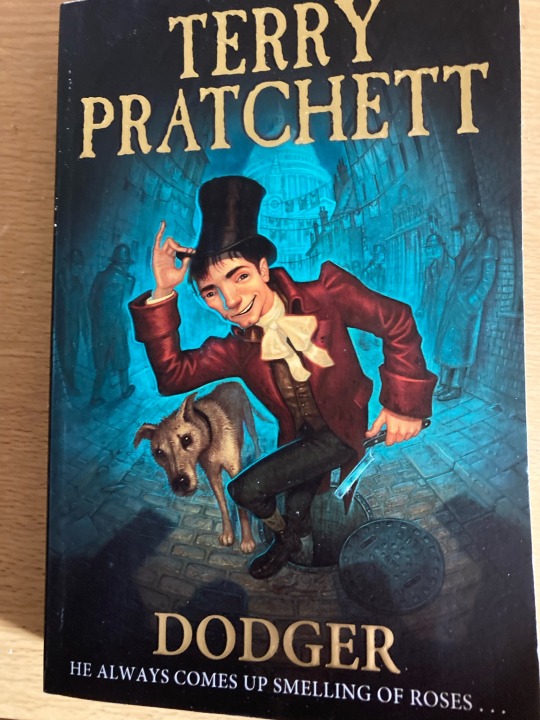
Owned: Yes Page count: 391 My summary: Everyone knows Dodger. He’s a tosher, scavenging in the sewers of London to earn a living, and coming home at night to his friend Solomon and the dog, Onan. But when he sees a young woman being beaten by a group of men, he has to intervene. Turns out she was running from some very important people. Now all eyes are on Dodger - and some of them aren’t friendly. My rating: 4/5 My commentary:
I gotta admit, I bought this book entirely on a whim. Literally, I just saw a quote from it on tumblr, thought that was interesting, looked up a summary, and then bought the book. Turns out, that was a good decision! I really enjoyed it, it’s different to a lot of the Pratchett books I’ve previously read (by which I mean exclusively Discworld) but not at all in a bad way. Although, I suppose it’s probably helpful that Victorian London’s not too different to Ankh-Morpork, from a certain point of view.
Dodger is great. He’s obviously based on the Artful Dodger, but is in-universe the inspiration for that character - early on, he meets Charles Dickens, then a reporter, and Dickens takes a great interest in his life. Dodger’s a really good example of a street-smart character; he’s not educated but he’s intelligent, and is ultimately a moral and decent person who doesn’t want to hurt others, and is angry at injustice on a practical level. This balances with Solomon, his friend and the anti-Fagin, who is a lot more high-minded and philosophical, though that doesn’t mean he’s without practical advice for Dodger as he moves through the upper echelons of society in order to figure out how to help Simplicity.
Speaking of, there is one issue I have with this book as a whole, and her name’s Simplicity. I don’t know what it is about Pratchett’s love-interest characters that annoy me at worst and bore me at best. Simplicity isn’t really given a lot of character. She’s a distressed damsel who Dodger needs to help, and that’s really all there is to her. There’s hints at her being more complex than that - the narration makes a lot of the idea that she’s not as simple as her name would imply - but I don’t think the reader’s ever really given any proof of that, nor really any reason that Dodger cares so much, besides the fact that she’s an attractive young lady and he has a crush. I’ve noticed this in Pratchett’s work in general, honestly - while he writes amazing older women, like Granny Weatherwax and Nanny Ogg, and a few of his younger women are also great, like Susan Sto Helit or Angua, if a female character is in a novel to fulfil the role of love interest, she is often underwritten and I am completely uninterested in her.
And, of course, it wouldn’t be a historical fiction novel without some cameos from real historical people. Charles Dickens, Benjamin Disraeli, Robert Peel...I do appreciate, however, that Pratchett sprinkled in some lesser-known personages in significant roles, particularly Angela Burdett-Coutts. It makes it all the stranger that Sweeney Todd also shows up in a significant role, though he’s not the sensationalised murderer and cannibal that we know about. Actually, Sweeney Todd plays an important thematic role in the novel - Dodger gently disarms him to stop Todd killing him, seeing that Todd’s only doing as he is because of some severe trauma from the war. This gets spun into Dodger being the Hero Who Took Down Murderer Sweeney Todd, despite Dodger protesting that he wasn’t a bad man, just a sad man. Todd ends up in Bedlam, and Dodger pays him a visit to make sure he isn’t being mistreated - but Todd goes down in history as a monster nonetheless. It’s an interesting through-line about stories, and how the narratives that survive about such people will be the only thing remembered by history, even if they aren’t true.
Next up, I take a wander through some kidlit.
6 notes
·
View notes
Text
BAB 5: PENTADBIRAN BARAT DI SARAWAK DAN SABAH
5.1 LATAR BELAKANG PEMERINTAHAN TEMPATAN
Sistem Kesukuan
· Sarawak: Iban( Tuai Rumah), Bidayuh( Tua Kapung), Kenyah( Peran Lepo), Kayan (Kelunan Maren), Melanau (Menteri), menyelesaikan pertelingkahan penduduk, memastikan keharmonian, dilantik mengikut kebolehan peribadi.
· **Sabah: **Orang Tua(Ketua Kampung), diamalkan oleh Kadazandusun, Murut, Bajau( matto’a sebagai pelindung adat, kepentingan anak buah). Majlis Kampung(membantu Orang Tua mengurus adat dan kehidupan seharian), Tukang-tukang Adat( memastikan upacara dilakukan betul bagi mengelakkan bencana).
Sistem Pentadbiran Tempatan
· ** ****SARAWAK: **3 bentuk iaitu Sungai Kerajaan, Sungai Tulin, Sungai Kuripan,Kawasan pedalaman ditadbir oleh Orang Kaya, Berdasarkan sistem penguasaan tanah. Sistem kedatuan: Kerajaan Sawaku ditadbir oleh Datu Merpati Jepang. Keturunannya bergelar Datu Patinggi, Datu Bendahara, Datu Temenggung menjadi wakil Sultan Brunei mentadbir dan membangunkan Sarawak tanpa campur tangan Sultan Brunei.
· ** ****SABAH: **barat dikuasai Kesultanan Brunei, Timur dikuasai Kesultanan Sulu. Brunei berdasarkan sistem penguasaan tanah oleh pembesar tempatan sebagai wakil sultan. Sistem Datu mewakili Sultan Sulu. Kuasa golongan Datu berdasarkan milikan bilangan hamba dan kemampuan menghantar ufti tetap.Sistem Ketua Bebas: sikap berani dan keperwiraan tokoh mencabar kewibawaan Sultan, berkait dengan keluarga Sultan Brunei atau Sulu, Mempunyai undang-undang sendiri dan tidak diiktiraf kuasa lain, menjalankan pentadbiran di kawasan masing-masing.
5.2 PELUASAN KUASA DINASTI BROOKE DI SARAWAK
Sarawak ketika Kehadiran James Brooke
· Sultan Omar Ali Saifuddin II, Sultan Brunei: 1827 berhasrat mengawal kegiatan perdagangan Sarawak. Pengiran Indera Mahkota mendirikan pusat penradbiran di Kuching mengenakan cukai tinggi dan kerahan tenaga.
· Pengiran Raja Muda Hashim: dihantar untuk menyelesaikan masalh di Sarawak. Bapa saudara Sultan , memujuk Datu Patinggi Ali dean pembesar Melayu tetapi gagal, Meminta bantuan James Brooke.
· **Datu Patinggi Ali: **pembesar tempatan Sarawak, penentangan untuk membebaskan Sarawak daripada cengkaman Pengiran Indera Mahkota. Berunding dengan James Brooke dan menamatkan penentanagan.
· James Brooke: menjalankan pengembaraan antara Sarawak dan Singapura dengan kapalnya Royalist. Sokongan angkatan tentera laut British.
James Brooke mendapatkan kuasa pemerintahan
· ** ****Rundingan:** dengan Pengiran Muda Hashim apabila diminta menyelesaikan pertelingkahan Sarawak, menawarkan Sarawak kepada James Brooke 2 kali.
· ** ****Ugutan: **1. Pengiran Raja Muda Hasim berdolak-dalik dan tidak bersetuju menyerahkan Sarawak, James mengugut sedia menyerang kedudukannya di Kuching.2. terhadap Sultan Omar Ali Saifuddin apabila James Brooke hadir ke Brunei diiringi angkatan tentera laut British untuk mengesahkan penyerahan.
· Perjanjian 1841: James Brooke dengan Pengiran Raja Muda Hashim, James memerintah Sarawak, menguasai hasilnya, menghormati, memelihara undang-undang adat Melayu. Perjanjian 1842: James Brooke dengan Sultan Brunei, menyerahkan Sarawak dari Tanjung Datu ke Sungai Samaraahan, James memberi ufti tahunan 2500 Dolar Sepanyol, tidak campur tangan dalam hal adat dan agama, tidak pindah milik tanpa izin Sultan Brunei. Mengiktiraf James sebagai Raja Putih Sarawak.
· **Ketenteraan: **sokongan kapal HMS Dido yang dimiliki angkatan tentera laut British. Memerangi ancaman lanun yang mengganggu perdagangan dan ketenteraman Sarawak.
Pengukuhan kuasa James Brooke
· ** ****Kekuatan Tentera:** kapal perang HMS Dido menghancurkan kubu kuat orang Iban di Sungai Saribas dan Sungai Skrang.
· ** ****Menentang Kebangkitan Orang Tempatan: **sebagai lanun, menjadi alasan meluaskan kuasa di kawasan orang Iban sebagai tindakan yang sah dan mendapat sokongan British.
· **Memperoleh sokongan sebahagian masyarakat tempatan: **Orang Melayu, Iban.
· Mengambil kesempatan daripada pertelingkahan yang wujud dalam masyarakat tempatan: Di Mukah, menyokong Pengiran Matusin yang berkonflik dengan Pengiran Ersat dan anaknya yang lebih dihormati. Membolehkannya memecahkan kekuatan masyarakat tempatan di Mukah.
· **Memperkukuh pertahanan Sarawak: **Benteng dan kubu dilengkapi dengan meriam. 1862, Renjer Sarawak ditubuhkan untuk mengawasi keamanan dan pertahanan.
· ** ****Sokongan kewangan: **pemodal Eropah terutama Baroness Angela Burdett-Counts.
5.3 PELUASAN KUASA SBUB DI SABAH
Kemakmuran Sabah menarik Pemodal Asing
· **Kedudukan strategic: **laluan perdagangan antara China dan Singapura, berhampiran Pulau Palawan yang merupakan laluan maritime kapal dagang ke China dan Jepun, penting dalam aktiviti perdagangan kepulauan Sulu hingga Papua New Guinea. Pelabuhan membolehkan kapal berlabur dengan selamat.
· **Kekayaan Ekonomi: **sarang burung mendapat pasaran di China. Sagu, rotan, getah perca, gamat, sirip ikan yu. Indigo dan kapas membolehkan pertanian komersial dijalan giat.
Sabah sebelum Penguasaan SBUB
· **Pulau Balambangan: **1763, Alexander Dalryample membuat perjanjian dengan Kesultanan Sulu, menghadapi masalah serangan lanun. Meninggalkan pulau pada November 1805.
· ** ****Pulau Labuan: **Sultan Brunei menyerahkan Labuan kepada British melalui perjanjian 18 Disember 1846, British bertanggungjawab menumpaskan lanun seta melindungi perdagangan. James Brooke Gabenor pertama.
Pertapakan SBUB
Sultan Brunei→Charles Lee Moses menyewa selama 10 tahun pada 1865→Menjual kepada J.W.Torrey dan T.B.Harris dan menjadikan Kimanis pusat perdagangan→Alfred, Edward Dent memajak pantai timur Sabah daripada Sultan Sulu 1878→Baron Gustavus von Overbeck berkerjasama dengan Alfred dan Edward memajukan Sabah→Torrey menjual kepada Baron→Julai 1881, Alfred Dent dan adiknya menubuhkan British North Borneo Provisional Association Ltd. Dan mendapat status piagam pada 1 November 1881→1888, Borneo Utara menjadi hegeri haungan British. SBUB memerintah Borneo Utara hingga tahun 1942.
Peluasan Kuasa SBUB
· ** ****Syarat piagam diraja:**** ** Menerima Penasihat British, melantik Pegawai Tadbir daripada pegawai diakui British, tidak dibenarkan diserahkan kepada pihak lain tanpa izin British. Memelihara adat resam, agama, undang-undang penduduk, adail, saksama.
· ** ****Matlamat: **pembangunan ekonomi malalui eksploitasi sumber dan melindungi, mempertahankan hak masyarakat tempatan.
· Sir Rutherford Alcock menjadi presiden pertama, Alfred Dent sebagai pengarah urusan, William Hood Treacher sebagai Gabenor pertama.
· Kuasa sebenar di London. Sistem birokrasi digunakan.
5.4 BENTUK PENTADBIRAN BARAT DI SARAWAK DAN SABAH
1. Pembahagian wilayah
· ** ****Sarawak: **Zaman Raja Brooke, 3 bahagian. Charles Brooke menambahkan 2 bahagian pada 1885 dan 1890. Bahagian pertama: Sg. Sarawak,Sadong. Bahagian kedua: Batang Lupar, Saribas, Kalaka, Simanggang. Bahagian ketiga: Sg Rajang, Oya, Mukah, Bintulu, Matu. Bahagian keempat: Sg. Baram. Bahagian kelima: Limbang, Trusan, Lawas.
· Sabah: Pada tahap awal, 2 residensi iaitu Residensi Pantai Timur berpusat di Sandakan, Residensi Pantai Barat berpusat di Jesselton. 1922, 5 residensi iaitu Kudat, Pantai Barat, Pedalaman, Pantai Timur dan Tawau berjumlah 17 daerah. Residen(Residensi), Pegawai Daerah, Penolong Pegawai Daerah berbangsa Inggeris atau Eropah.
2. Pengekalan pembesar tempatan
· Sarawak: Kalangan Datu dikekalkan, jawatan baharu Datu Imam, Datu Hakim. Zaman Charles Vyner Brooke, Datu Menteri, Datu Pahlawan, Datu Bentara, Datu Amar. Semua undang-undang, adat tidak bercanggah dengan sistem Barat dikekalkan. Pembesar tidak memungut cukai, diberi gaji, membantu pentadbiran.
· ** ****Sabah:** SBUB membahagikan Ketua Anak Negeri diakui diserap ke dalam sistem pentadbiran dan diberi gaji, Ketua Anak Negeri tidak diakui tidak dibayar gaji. Ketua bergaji memelihara keamanan, mengutip cukai kepala, mentadbir keadilan, hakim di Mahkamah Anak Negeri. Juga digelar Orang Kaya(O.K.) membantu Pegawai Daerah menjalankan pentadbiran daerah. Institusi Ketua Anak Negeri, Ketua Kampung (Orang Tua), Mahkamah Anak Negeri.
3.Pentadbiran berhierarki
· Sarawak: Raja→Majlis tertinggi/Majlis Negeri→Residen(Bahagian)→Pegawai Daerah→Penghulu
· Sabah: Lembah Pengarah(Pemegang Saham)→Gabenor(Majlis Penasihat menasihati dalam hal ehwal pentadbiran)→Setiausaha→Ketua Jabatan/ Residen→Pegawai Daerah→Ketua Anak Negeri→Ketua Kampung
4. Pentadbiran berasaskan Kaum
· ** ****Sarawak: **sistem pecah dan pemerintah, Melayu(pentadbiran),Cina(ekonomi, sitem Kapitan, Kangcu), Iban(keselamatan,ketenteraan, Temenggung).
· ** ****Sabah:** berasaskan peribumi, Penolong Pegawai Daerah(pentadbir), ketua etnik berperanan dan dipilih berdasarkan personaliti dan kepakaran.
5. Perundangan
· ** ****Sarawak: **Undang-undang lapan perkara(Januari 1842), Mahkamah diadili raja, dibantu ketua Majistret, Mahkamah Residen( Residen sebagai Majistret), Mahkamah Adat( mengadili kesalahan masyarakat tempatan), Mahkamah Cina di Kuching(kes masyarakat Cina).
· ** ****Sabah:** undang-undang barat dan tempatan, Mahkamah Majistret(undang-undang Barat ,diadili Pegawai Daerah), Mahkamah Anak Negeri( diadili Ketua Anak Negeri).
3 notes
·
View notes
Text
Aaron Burr

Aaron Burr Jr. was born on February 06, 1756 in Newark, New Jersey, British America. His parents were Aaron Burr Sr. [1716-1757] and Esther Edwards [1732-1758]. He had an older sister: Sarah "Sally" Burr Reeve [1754-1797].
In 1782 he married Theodosia Bartow Prevost [1746-1794]. After his first wife's death, he married Eliza Jumel [1775-1865] in 1833. Four months after they married they filed for divorce. Three years later in 1836 the divorce was finalized.
Aaron Burr Jr. had two [2] daughters with Theodosia: Theodosia Burr Alston [1783-1813] and Sally Reeve Burr [1785-1788]. With two [2] other women he also had daughters: Frances Ann Burr [born c.1829] and Elizabeth Burr [born c.1833]. He adopted two [2] sons: Aaron Columbus Burr (born as Aaron Burr Columbe) [1808-1882] and Charles Burdett Burr [1814-1862]. He parented his two [2] stepsons: Augustine James Frederick Prevost and John Bartow Prevost. Nathalie de Lage de Volude [1782-1841] and John Vanderlyn [1775-1852] were just two [2] of many that he was a guardian/mentor toward. With Mary Emmons [c.1760-c.1832] he had a daughter, Louisa Charlotte Burr [born 1788] and a son, John Pierre Burr [1792-1864] that he never acknowledged.
He was the 3rd Vice President of the United States [March 04, 1801 - March 04, 1805]. He was a Democratic-Republican.
Aaron Burr Jr. held three [3] other offices. The first as a Member if the New York State Assembly from New York County [July 01, 1784 - June 30, 1785]. The second as the 3rd Attorney General of New York [September 29, 1789 - November 08, 1791]. The third as the United States Senator from New York [March 04, 1791 - March 03, 1797].
He served in the Continental Army [1775-1779]. He reached the rank of Lieutenant Colonel.
In the American Revolutionary War, Aaron Burr Jr. took part in the Battle of Quebec and the Battle of Monmouth.
Aaron Burr Jr. died on September 14, 1836 (aged 80) in Staten Island, New York, U.S.. He was laid to rest at Princeton Cemetery in Princeton, New Jersey, U.S..
#vice president#history#military#personal life#office#aaron burr#american history#attorney general#senator
6 notes
·
View notes